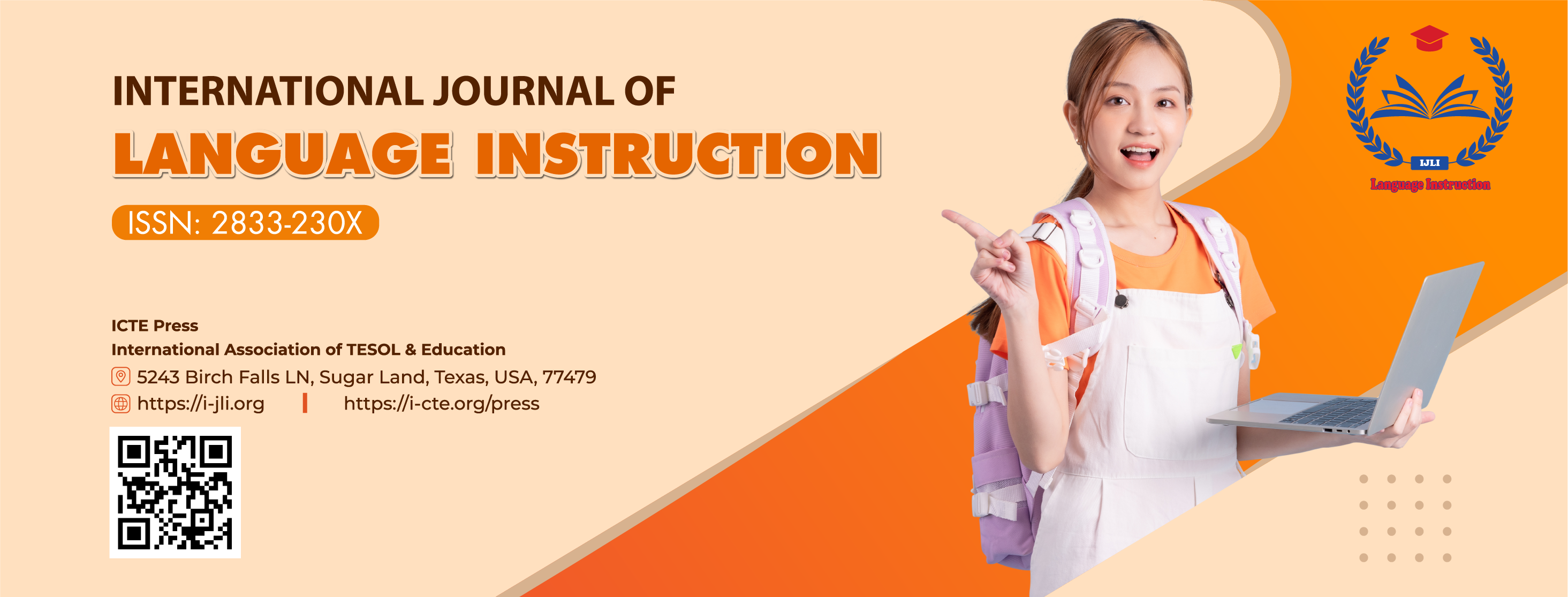Effects of Using Technology to Engage Students in Learning English at a Secondary school
DOI:
https://doi.org/10.54855/ijli.22118Keywords:
technology, interest, participation, engagementAbstract
In recent years, more and more teachers are applying technology to improve teaching quality and help students learn more actively. This study investigates the impact of technology on engaging students to learn English and explores students' attitudes towards the use of technology in the classroom. This study aims to develop useful suggestions for educators, students, and teachers in secondary schools to engage students in learning English, thereby improving the quality of education. Besides, it encourages teachers to use technology in the classroom to enhance students’ interests. This study was conducted at a Secondary School in Kien Giang province, with 45 students responding to the questionnaire with items about their attitudes towards technology used in the classroom. Additionally, the involvement of 6 English teachers in interviews also helped to deepen the understanding of teachers' beliefs about using technology to attract students to learn English. The findings of the study show that technology had a significant impact on students’ engagement.
References
Ahmadi, D., & Reza, M. (2018). The use of technology in English language learning: A literature review. International Journal of Research in English Education, 3(2), 115-125.
D'Angelo, C. (2018). The impact of technology: Student engagement and success. Technology and the Curriculum: Summer 2018.
Dixson, M. (2015). Measuring student student engagement engagement in the online online Coursecourse: The Online online Student student Engagement engagement Scale scale (OSE). Online Learning, 19(4). Retreived from https://files.eric.ed.gov/fulltext/EJ1079585.pdf
Gashi Shatri, Z. (2020). Advantages and disadvantages of using information technology in the learning process of students. Journal of Turkish Science Education, 17(3), 420-428.
Gömleks, M. N. (2004). Gömleksiz, M. N. (2004). Use of Education Technology in English Classes. Turkish Online Journal of Educational Technology-TOJET, 3(2), 71-77.
Inoue-Smith, Y. (2016). College-based case studies in using PowerPoint effectively. Cogent Education, 3(1), 1127745.
Kasapoğlu-Akyol, P. (2010). Using educational technology tools to improve language and communication skills of ESL students. Novitas-Royal, 4(2), 225-241.
Kaur, P., & Naderajan, R. (2019). Kahoot in the English language classroom. South East Asia Journal of Contemporary Business, Economics and Law, 20(6), 49-54.
Kaur, P., & Nadarajan, R. (2020). Language learning and teaching using Kahoot. International Journal of Modern Education, 2(5), 19-28.
Lari, F. S. (2014). The impact of using PowerPoint presentations on students’ learning and motivation in secondary schools. Procedia-Social and Behavioral Sciences, 98, 1672-1677.
Lester, D. (2013). A review of the student engagement literature. FOCUS on Colleges, Universities & Schools, 7(1), 1-8.
Madiseh, F. R., Al Abri, A., & Sobhanifar, H. (2022). Integration of Mentimeter into the Classroom: A Scoping Review.
Martin, F., & Bolliger, D. U. (2018). Engagement matters: Student perceptions on the importance of engagement strategies in the online learning environment. Online Learning, 22(1), 205-222.
Mustafa, E. N. E. (2018). The impact of YouTube, Skype and WhatsApp in improving EFL learners' speaking skills. International Journal of Contemporary Applied Research, 5(5), 18-31.
Nguyen, T. M. N. (2022). Effects of Using Computer-Based Activities in Teaching English Speaking at a High School in Ho Chi Minh City, Vietnam. International Journal of TESOL & Education, 2(1), 190–212. https://doi.org/10.54855/ijte.222112
Nguyen, T. T. H. (2021). Implementing Digital Techniques to Stimulate EFL Students’ Engagement: A Case Study in Vietnam. International Journal of TESOL & Education, 1(3), 105–129. Retrieved from https://i-jte.org/index.php/journal/article/view/81
Yunus, M. M., Nordin, N., Salehi, H., Embi, M. A., & Salehi, Z. (2013). The use of information and communication technology (ICT) in teaching ESL writing skills. English language teaching, 6(7), 1-8.
Saeed, S., & Zyngier, D. (2012). How motivation influences student engagement: A qualitative case study. Journal of Education and learning, 1(2), 252-267.
Sharma, H. L., & Pooja, L. (2016). Enhancing students' interest in English language via multimedia presentation. International Journal of Applied Research, 2(1), 275-281.
Tarantino, K., McDonough, J., & Hua, M. (2013). Effects of student engagement with social media on student learning: A review of literature. The Journal of Technology in Student Affairs, 1(8), 1-8.
Tran, T. Q. (2021). Social Networking: A Collaborative Open Educational Resource. International Journal of TESOL & Education, 1(2), 148–157. Retrieved from https://i-jte.org/index.php/journal/article/view/41.
Tuma, F. (2021). The use of educational technology for interactive teaching in lectures. Annals of Medicine and Surgery, 62, 231-235.
van Wyk, G., & Louw, A. (2008). Technology Assisted Reading for Improving Reading Skills for young South African Learners. Electronic Journal of e-Learning, 6(3), pp245-254.
Yundayani, A., Susilawati, S., & Chairunnisa, C. (2019). Investigating the effect of canva on students’ writing skills. English Review: Journal of English Education, 7(2), 169-176.
Downloads
Published
Issue
Section
License
Copyright (c) 2022 Pham Thi Chuong

This work is licensed under a Creative Commons Attribution-NonCommercial 4.0 International License.
The copyright of all articles published in the International Journal of Language Instruction (ijli) remains with the Authors, i.e. Authors retain full ownership of their article. Permitted third-party reuse of the open access articles is defined by the applicable Creative Commons (CC) end-user license which is accepted by the Authors upon submission of their paper. All articles in the ijli are published under the CC BY-NC 4.0 license, meaning that end users can freely share an article (i.e. copy and redistribute the material in any medium or format) and adapt it (i.e. remix, transform and build upon the material) on the condition that proper attribution is given (i.e. appropriate credit, a link to the applicable license and an indication if any changes were made; all in such a way that does not suggest that the licensor endorses the user or the use) and the material is only used for non-commercial purposes.
Authors are able to enter into separate, additional contractual arrangements for the non-exclusive distribution of the journal's published version of the work (e.g., post it to an institutional repository, in a journal or publish it in a book), with an acknowledgment of its initial publication in this journal.











